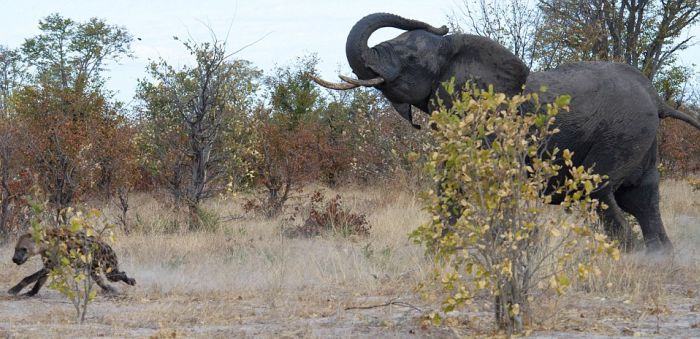|
|
Elephant Saves Her Baby Against Hyenas
|
The spotted hyena diverged from the striped and brown hyena 10 million years ago. Its direct ancestor was the Indian Crocuta sivalensis, which lived during the Villafranchian. Ancestral spotted hyenas probably developed social behaviours in response to increased pressure from rivals on carcasses, thus forcing them to operate in teams. Spotted hyenas evolved sharp carnassials behind their crushing premolars, therefore they did not need to wait for their prey to die, as is the case for brown and striped hyenas, and thus became pack hunters as well as scavengers. They began forming increasingly larger territories, necessitated by the fact that their prey was often migratory, and long chases in a small territory would have caused them to encroach into another clan's turf. Spotted hyenas spread from their original homeland during the Middle Pleistocene, and quickly colonised a very wide area from Europe, to southern Africa and China. With the decline of grasslands 12,500 years ago, Europe experienced a massive loss of lowland habitats favoured by spotted hyenas, and a corresponding increase in mixed woodlands. Spotted hyenas, under these circumstances, would have been outcompeted by wolves and humans, who were as much at home in forests as in open lands—and in highlands as in lowlands. Spotted hyena populations began to shrink after roughly 20,000 years ago, completely disappearing from Western Europe between 14-11,000 years ago, and earlier in some areas.
Genera of the Hyaenidae (extinct and recent)
The list follows McKenna and Bells Classification of Mammals for prehistoric genera (1997) and Wozencraft (2005) in Wilson and Reeders Mammal Species of the World for extant genera. The Percrocutids are, in contrast to McKenna and Bell's classification, not included as a subfamily into the Hyaenidae, but as the separate family Percrocutidae. Furthermore, the living brown hyena and its closest extinct relatives are not included in the genus Pachycrocuta, but in the genus Hyaena. The Protelinae (Aardwolves) are not treated as a separate subfamily, but included in the Hyaeninae.
|
|









